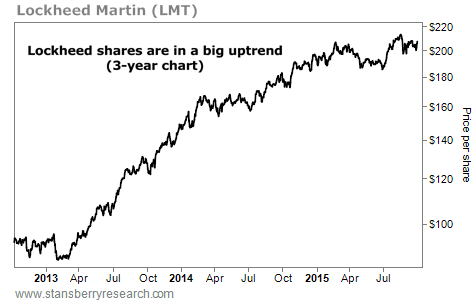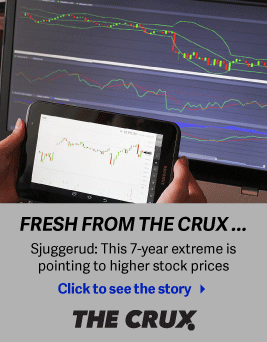| Home | About Us | Resources | Archive | Free Reports | Market Window |
The Secret to Creating a Growing BusinessBy
Friday, October 2, 2015
I have devoted much of my outside reading this year to one topic: learning more about how companies get bigger and better.
Companies that crack the code to efficient, profitable growth tend to make great long-term investments.
In today's essay, I'll share what I've learned about how companies get bigger and better... and show you two examples of companies doing it the right way...
One excellent new book on this topic is Scaling Up Excellence. Co-authors Robert Sutton and Huggy Rao are Stanford professors who spent seven years conducting hundreds of interviews and collecting thousands of stories. They compiled the most important ones into this book.
"Scaling" – or dramatically increasing revenue without diminishing quality or profitability – is an obvious high priority for nearly every business. But increasing revenue without hurting quality or profitability is a big challenge.
Netflix, the world's leading video-streaming network, is a great example of successful scaling... In 2007, the company pioneered the streaming of movies and television shows over the Internet. Eight years later, it has collected more than 57 million streaming members in nearly 50 countries, and has almost quintupled revenue from $1.2 billion to $5.5 billion.
CEO Reed Hastings attributes much of Netflix's success to them hiring the same way a professional sports team does. He wants star players in every position, and he pays top dollar to acquire and retain them. According to Sutton and Rao, Netflix pays top-of-the-market salaries, even by Silicon Valley standards.
One executive they interviewed told a story about hiring a new engineer who lived on the East Coast and needed to relocate to California. The agreed-upon salary was $150,000. But before the new hire arrived, a Netflix market survey indicated the salary was below the top of the market – so they immediately raised his pay to $250,000!
Stocking Netflix management with talented team players means fewer rules and bosses are necessary. These highly marketable employees initially take the jobs because of the top pay, but end up staying because they have autonomy to make their marks on the company.
Another excellent new book about how companies get bigger and better is Design to Grow: How Coca-Cola Learned to Combine Scale & Agility. The primary author is David Butler, Coca-Cola's Vice President of Innovation and Entrepreneurship.
According to Butler, for the first 70 years of its existence (from the mid-1880s to the mid-1950s), Coca-Cola had just one product, one package size, and essentially one price ($0.05).
Over those seven decades, the company gradually scaled up to become the World Dominator of carbonated cola beverages by perfecting the integration of ingredient sourcing, manufacturing, distribution, and marketing into a system it could replicate anywhere in the world.
In 1982, Coca-Cola added a second major product: Diet Coke.
Then in 2001, with the market for carbonated beverages maturing, the company embarked on an ambitious mission to become the world's foremost "total beverage company." Management wanted to extend beyond colas into all other types of beverages, including water, juice, milk, and coffee. It also wanted to earn the No. 1 share in each of these markets.
Just 14 years later, Butler says Coca-Cola now sells 3,500 different products and 500 brands (including 100 different brands of water) in 200 countries. The company owns 17 billion-dollar brands and sells two billion products each day.
The infrastructure that this World Dominator has created is equally impressive: partnerships with more than 20 million retail customers, 80,000 suppliers, and a network of 250 bottling companies.
Butler believes billion-dollar brands like Coca-Cola, Pampers, and Kleenex only maintain dominant status by finding new ways to create competitive advantages and relevance.
In his opinion, scale is not enough to maintain dominance in today's fast-moving, technologically advanced marketplace. Big companies with massive scale must also develop agility or face the risk of becoming irrelevant, like Blockbuster and Kodak did.
Butler provides an excellent example of Coke embracing agility through its growing adoption of Manual Distribution Centers ("MDCs") in Africa. The concept was initially created by Coca-Cola's South African bottling partner (Coca-Cola Sabco) about six years ago to address distribution challenges in Ethiopia.
Unlike in developed markets like the U.S. and Europe, Coke products can't be delivered to retail customers via truck in Ethiopia. Not only are the typically narrow dirt roads incapable of accommodating truck traffic, the shops are small and have limited security and electricity.
In response to these limitations, Sabco created MDCs to distribute Coca-Cola products to shops, restaurants, and one-person kiosks using pushcarts, bicycles, donkeys, and even small boats.
Within three years, the MDC program had become so successful that Sabco began using it in all of its East African markets. Today, Butler says that more than 80% of Coca-Cola's volume in Ethiopia is distributed through MDCs. In Kenya and Uganda, the numbers are even higher: 90% and 99%, respectively.
In short, getting bigger is a primary objective of virtually every business on the planet, but only the best ever figure out how to grow dramatically larger without negatively impacting the quality of their products – or their profitability.
Today, our fast-paced, technologically advanced world is also creating new business threats and opportunities that often require quick action. Business models that embrace agility – like Coca-Cola did in Africa – are therefore the likely winners.
If you’re looking for great long-term investments, focus on those demonstrating an ability to scale and adjust quickly to new market realities.
Good investing,
Mike Barrett
Further Reading:
Earlier this year, Mike showed readers why just buying the world's best businesses isn't enough if you want to succeed in the stock market. "This is one of the most important lessons I can teach you about buying stocks," he says. Find out what it is right here.
"If you study what I'm about to teach you," Dan Ferris writes, "you will be able to identify companies that 'jump off the page' as wonderful investments you'd like to own one day." The best part is, you won't have to pick stocks anymore: "They'll pick you!" Get all the details right here.
Market NotesTHIS 'OFFENSE' GIANT KEEPS CHUGGING ALONG The market has slowed down significantly over the past couple of months... but the bull market in government spending is still on. Just look at today's chart of elite "offense" contractor Lockheed Martin (LMT) for proof.
Longtime readers know our stance on the defense sector. In short, our government is involved in so many foreign wars and spends so much money that it should be called the "offense" industry.
Giant defense firm Lockheed produces things like jet fighters, missiles, radar systems, and unmanned aerial drones. Its business relies almost entirely on government spending... and its performance over the past few years shows that spending hasn't slowed down.
As you can see in the chart below, the stock is locked into a steady, long-term uptrend. Shares have climbed nearly 120% over the past three years. And Lockheed is still rising despite the recent market selloff. The stock is up almost 10% since July, while the S&P 500 is down more than 8%. As long as the U.S. government continues to spend, "offense" contractors like Lockheed will keep rising.
 |
Recent Articles
|



